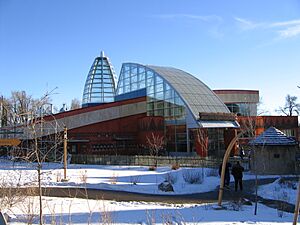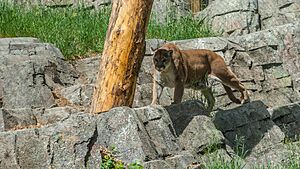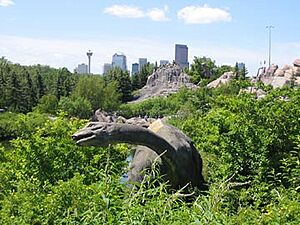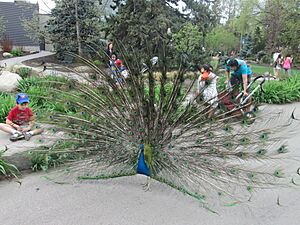Calgary Zoo facts for kids
 |
|
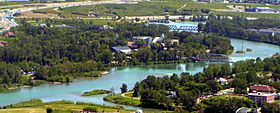
Wilder Institute/Calgary Zoo on St. George's Island
|
|
| Date opened | 9 January 1929 |
|---|---|
| Location | Calgary, Alberta, Canada |
| Land area | 0.3 km2 (0.12 sq mi) |
| Coordinates | 51°02′45″N 114°02′00″W / 51.04583°N 114.03333°W |
| No. of animals | Over 4,000 |
| No. of species | Over 100 |
| Annual visitors | 1.54 million |
| Memberships | WAZA, AZA, IUCN |
| Major exhibits | Penguin Plunge, Land of Lemurs, Wild Canada, Prehistoric Park, Destination Africa, Exploration Asia |
| Website | https://www.calgaryzoo.com/ |
The Wilder Institute/Calgary Zoo is a super cool place to visit in Calgary, Alberta, Canada. It's located just east of the city's downtown area. You can easily get there by C-Train (a light rail system), by car, or even by bike or walking along the Bow River pathway. A big part of the zoo is on St. George's Island, right in the middle of the Bow River.
The zoo is run by the Calgary Zoological Society. This is a special not-for-profit group that helps animals and nature. It's one of the oldest charities in Alberta! The zoo is recognized by big organizations like the AZA and the WAZA. This means it meets high standards for animal care and conservation.
The Wilder Institute/Calgary Zoo is home to over 1,000 animals. These animals represent 272 different species. The zoo covers 125 acres and has different areas to explore. These include Destination Africa, Wild Canada, Penguin Plunge, and Prehistoric Park. It's open almost every day of the year, except for Christmas Day.
As of 2023, it's the most visited zoo in Canada. It's also known worldwide for its amazing work in conservation research. In 2013, the AZA called it one of the "top zoos in the world."
Contents
History of the Zoo
St. George's Island was once Calgary's first park. People loved to go there for picnics and to relax. The zoo started small in 1917 with just two mule deer on the island. More local animals joined them as the park became more popular. The Calgary Zoological Society was officially started on January 9, 1929. This group then took over running the zoo.
In June 1929, floods hit the island, and some animals sadly died.
In 1937, the Banff Zoo closed, and many of its animals moved to Calgary. This helped the Calgary Zoo become the biggest animal collection in the area.
In 1972, the zoo started a campaign called "Ban the Bars." This was to make animal homes more natural and less like old-fashioned cages.
New areas opened over the years. Destination Africa opened in 2003, showing off animals from the African continent. Penguin Plunge, a cool home for Antarctic penguins, opened in 2012.
In 2013, the zoo shared a big plan to rebuild and improve the zoo over 20 years. A main goal was to get ready for two giant pandas. Four giant pandas arrived in 2018 after twins were born at the Toronto Zoo. The panda cubs went back to China in January 2020. Their parents followed in November 2020. This happened because it was hard to get enough bamboo for them during the COVID-19 pandemic.
In 2021, the Calgary Zoo Foundation changed its name to the Wilder Institute. Now, the zoo is known as the Wilder Institute/Calgary Zoo.
In 2025, the Wilder Institute and its partners announced an exciting discovery. They found a new species of butterfly called the Curiously Isolated Hairstreak!
The 2013 Flood
In June 2013, the Calgary area had huge floods. The island part of the zoo and some other areas were badly damaged. Zoo staff worked quickly to move 140 animals to higher, safer ground. Sadly, some fish, two peacocks, and a pot-bellied pig were lost. The zoo was closed for most of July 2013. Parts of it reopened in August, and the whole zoo was open again by November 2013. New animals and exhibits, like mandrills and Komodo dragons, were added in 2014.
Explore the Zoo's Destinations
Destination Africa
Opened in 2003, Destination Africa was one of the zoo's biggest projects. It has four buildings, including the Rainforest and the African Savannah. The Rainforest is a large indoor area with plants and animals from African rainforests. The African Savannah building is home to hippos, Masai giraffes, and red river hogs. You can even see the hippos swimming underwater in a huge pool!
When it's warm, the doors open to connect the building to the outdoor Savannah exhibit. Here, you can see Hartmann's mountain zebras, grey crowned cranes, and ostriches. African lions also live in the Savannah exhibit. In the Rainforest, you'll find primates like western lowland gorillas and mandrills. There are also reptiles like leopard tortoises and dwarf crocodiles, plus many African birds.
Land Of Lemurs
In 2017, the Land of Lemurs opened. This area is home to three different kinds of lemurs: the black-and-white ruffed lemur, the ring-tailed lemur, and the red-fronted lemur.
Wild Canada
The Wild Canada area was built in the 1990s. It houses most of the zoo's North American birds and mammals. This area has outdoor spaces designed to look like three different Canadian environments: the Aspen Woodlands, the Northern Forest, and the Rocky Mountains. Animals you might see here include river otters, caribou, bighorn sheep, grizzly bears, polar bears, muskoxen, moose, and grey wolves.
Jihad Shibley Rocky Mountain Aviary
This aviary is a special bird house. It's home to birds like the great grey owl, snowy owl, and rough-legged hawk.
Dorothy Harvie Botanical Gardens and ENMAX Conservatory
The outdoor gardens are very popular at the zoo. They include the Dorothy Harvie Gardens. The zoo's location helps many different kinds of plants grow well. The ENMAX Conservatory is the indoor part of the gardens. It has different "themed" areas like a tropical garden, a rainforest, and a butterfly garden. You can also see some animals, like birds and insects, inside the conservatory. The ENMAX Conservatory was updated in 2009. It now teaches visitors even more about how important plants are and how to save energy. The Wilder Institute/Calgary Zoo even earned a special award for being energy-efficient and building responsibly.
Exploration Asia
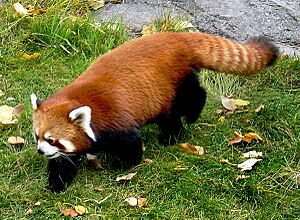
The western part of St. George's Island is dedicated to animals from Eurasia. Here you can find amazing creatures like Amur tigers, snow leopards, Pallas's cats, Japanese macaques, red pandas, and Komodo dragons. This area was also home to four giant pandas from China from 2018 until 2020. The pandas returned to China because it became difficult to get enough bamboo for them during the COVID-19 pandemic.
The area where the pandas lived is now called Gateway to Asia. It has new animals like Malayan tapirs and white-handed gibbons. In February 2025, the zoo announced big plans to redevelop the Exploration Asia zone. The first part, 'Asia Highlands', will focus on animals from Southeast Asia, the Eastern Himalayas, and Northeast Asia. It's expected to be finished in summer 2026.
Prehistoric Park
The Wilder Institute/Calgary Zoo's six-acre Prehistoric Park is like stepping back in time! It has life-sized dinosaur models in their natural-looking environments. You can see replicas of an inland sea and a volcanic mountain, surrounded by over 100 types of living plants. Some of the dinosaurs you'll find here include Albertosaurus, Allosaurus, Ankylosaurus, Apatosaurus, Triceratops, and Tyrannosaurus rex.
Penguin Plunge
Penguin Plunge opened in spring 2012 and is near the zoo's entrance. This exhibit is home to king penguins, Humboldt penguins, gentoo penguins, and rockhopper penguins. It has two main areas: an indoor, climate-controlled habitat and an outdoor area. In summer, the warm-weather South American Humboldt penguins are outside. On certain winter days, when the weather is just right, the king penguins go on scheduled walks outside for exercise and fun!
Other Animals at the Zoo
The zoo also has a group of Chilean flamingos. Nearby, you can see alpacas and greater rheas. You might even spot Indian peafowl walking freely around the zoo grounds! They are moved to a special off-site facility during the winter.
In the past, the zoo had areas for South American animals like giant anteaters and different kinds of New World monkeys. There was also an Australian animal section, which once had kangaroos and emus.
Conservation Efforts
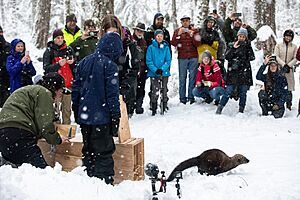
The zoo cares for 44 species that are part of Species Survival Plans. These are global efforts to protect animals that are at risk. Twenty-nine species at the zoo are in danger of extinction. Other animals are "ambassadors" to help people learn about endangered species. The Wilder Institute/Calgary Zoo has a team of experts, including animal care technicians and teachers. They help visitors learn about nature's beauty and the dangers animals face. Each year, over 575,000 adults and children learn from the zoo's programs.
The Wilder Institute/Calgary Zoo has a team of biologists who are known worldwide. They are leaders in helping species recover and return to the wild. The science journal Nature ranks the Wilder Institute/Calgary Zoo as one of the top five zoos in the world for conservation research.
The zoo focuses on saving eight highly endangered species from Western Canada. These include the whooping crane, Vancouver Island marmot, and swift fox. It also works on conservation projects around the world, such as:
- Helping hippos in Ghana.
- Protecting snow leopards in Central Asia.
- Saving gorillas in the Democratic Republic of the Congo.
In 2008, the zoo's project in Ghana, which involved 17 villages, won a United Nations award. It was recognized as one of the world's top 25 conservation projects. It has become a great example for conservation efforts across Africa.
Notable Animal Births
In March 2012, Amur tiger Katja gave birth to three Amur tiger cubs at the zoo. This was a big deal because this tiger species is very endangered. The births increased the global population by 1%! In 2014, two of the male cubs, Vasili and Samkha, moved to the Assiniboine Park Zoo in Winnipeg to help with future breeding programs. Vasili later moved to the Toronto Zoo in 2018.
In early 2016, a western lowland gorilla infant named Kimani was born. She was small at birth but grew quickly. Sadly, Kimani passed away in 2022 after battling cancer.
In August 2016, a king penguin chick named Edward hatched. The next year, another king penguin chick hatched and was named Cleopatra.
In May 2017, a Przewalski's horse foal was born at the zoo's Wildlife Conservation Centre. This birth was important for the genetic diversity of this endangered wild horse.
In June 2018, a bactrian camel calf named Gobi was born to mother Eva.
Events
Zoolights
Zoolights is a fun Christmas lights festival held every year at the zoo. It usually runs from late November to early January. This month-long show features over one million lights shaped like animals. It's the biggest seasonal light show in western Canada!
Zoo Safety and Care
The Wilder Institute/Calgary Zoo works hard to ensure the safety and well-being of all its animals and visitors. Like any large facility, the zoo has experienced incidents over the years. Each time, the zoo reviews what happened and makes improvements.
For example, in 2009, an object was accidentally left in a gorilla enclosure. The zoo quickly reviewed its procedures to prevent this from happening again. In December 2009, a young capybara died in an accident involving a hydraulic door. The zoo found that a worker did not follow a safety procedure. In September 2010, two Siberian tiger cubs died shortly after birth. Zookeepers were not aware the mother was pregnant, and the cubs suffered injuries.
After these events, the zoo asked for an independent review. The report, released in 2010, pointed out areas for improvement. In response, the zoo created a 36-point plan. This plan focused on making animal care procedures better, improving staff training and safety drills, and upgrading older parts of the zoo. They also hired an animal welfare expert to lead these changes.
Other incidents have also led to improvements:
- In October 2011, a corn snake died after being left near a heat source. The zookeeper involved resigned.
- In September 2014, a sensor problem in the hippopotamus pool led to the deaths of 85 tilapia fish.
- In February 2016, an otter drowned after getting tangled in an item given to it by a zookeeper.
- In December 2016, seven Humboldt penguins drowned in a holding pool.
- In May 2023, a Masai Giraffe died from a broken neck after its ossicone (horn-like structure) got caught in a cable.
- In July 2024, one of the zoo’s popular polar bears, Baffin, died by drowning during rough play with another bear.
Each of these incidents led to thorough investigations and changes in procedures to prevent similar events. The zoo is always working to improve its animal care and safety systems.
See also
 In Spanish: Zoológico de Calgary para niños
In Spanish: Zoológico de Calgary para niños


